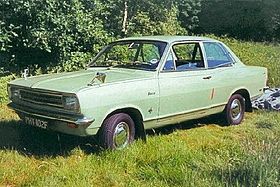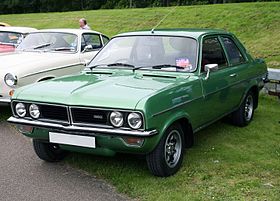Vauxhall Viva (1963–1979)
| Vauxhall Viva | |
|---|---|

Vauxhall Viva HC Series
|
|
| Overview | |
| Manufacturer | Vauxhall (General Motors) |
| Production | 1963–1979 1,516,792 produced |
| Assembly | Ellesmere Port, Cheshire, England |
| Body and chassis | |
| Class | Small family car (C) |
| Chronology | |
| Successor |
Vauxhall Astra Vauxhall Chevette |
| Vauxhall Viva HA | |
|---|---|

Vauxhall Viva HA Series
|
|
| Overview | |
| Also called | Vauxhall Epic (France, Algeria, Tunisia) Envoy Epic (Canada) |
| Production | 1963–1966 |
| Assembly |
|
| Body and chassis | |
| Body style | 2-door saloon |
| Related |
Bedford HA Bedford Beagle |
| Powertrain | |
| Engine | 1,057 cc (64.5 cu in) ohv inline 4 |
| Transmission | 4-speed manual all-synchromesh |
| Dimensions | |
| Wheelbase | 91.5 in (2,324 mm) |
| Length | 155 in (3,937 mm) |
| Width | 59.5 in (1,511 mm) |
| Height | 53.25 in (1,353 mm) |
| Kerb weight | 1,564 lb (709 kg) (standard) 1,628 lb (738 kg) (90 SL) |
| Chronology | |
| Successor | HB Viva |
| Vauxhall Viva HB | |
|---|---|

Vauxhall Viva HB Series
|
|
| Overview | |
| Also called | Envoy Epic (Canada) |
| Production | September 1966 – July 1970 |
| Body and chassis | |
| Body style | 2-door saloon 4-door saloon 3-door estate |
| Related | Holden Torana |
| Powertrain | |
| Engine | 1159 cc ohv Inline-four engine 1599 cc Slant-4 I4 1975 cc Slant-4 I4 (GT) |
| Transmission | 4-speed manual all-synchromesh optional Borg Warner Type 35 automatic from February 1967 |
| Dimensions | |
| Wheelbase | 95.75 in (2,432 mm) |
| Length | 161.6 in (4,105 mm) |
| Width | 63 in (1,600 mm) |
| Height | 53.3 in (1,354 mm) |
| Curb weight | 1,698 lb (770 kg) (standard) 2,070 lb (939 kg) (GT) |
| Chronology | |
| Predecessor | HA Viva |
| Successor | HC Viva |
| Vauxhall Viva HC | |
|---|---|

Vauxhall Viva HC Series
|
|
| Overview | |
| Production | 1970–1979 |
| Body and chassis | |
| Body style | 2-door saloon 4-door saloon 3-door estate |
| Related |
Vauxhall Magnum Vauxhall Firenza Chevrolet Firenza |
| Powertrain | |
| Engine | 1159 cc OHV I4 1256 cc OHV I4 1759 cc Slant-4 I4 2279 cc Slant-4 I4 |
| Transmission | 4-speed manual GM-Automatic (with 1,759 & 2,279 cc engines: Viva SL only) |
| Dimensions | |
| Wheelbase | 97 in (2,464 mm) |
| Length | 162.875 in (4,137 mm) |
| Width | 64.75 in (1,645 mm) |
| Height | 53 in (1,346 mm) |
| Curb weight | 1,837 lb (833 kg) - 2,237 lb (1,015 kg) |
| Chronology | |
| Predecessor | HB Viva |
| Successor |
Vauxhall Chevette Vauxhall Astra |
The Vauxhall Viva is a small family car produced by Vauxhall in a succession of three versions between 1963 and 1979. These were designated as the HA, HB and HC series.
The Viva was introduced a year after Vauxhall's sister company Opel launched the Opel Kadett A. Visually the two cars' kinship was obvious. A van version was also produced, as the Bedford HA. In the UK the Viva's principal competitors at the time of its launch included the well-established Ford Anglia and Morris Minor.
The third generation HC series was the last solely Vauxhall designed passenger car when it ceased production in 1979, since all future Vauxhalls would be badge engineered Opel models.
The HA Viva, announced in September 1963, and replaced in September 1966, was Vauxhall's first serious step into the compact car market after the Second World War. It was also the first new small car produced by Vauxhall since 1936. The HA Viva was powered by a 1,057 cc (64.5 cu in), overhead valve, four cylinder, front-mounted engine driving the rear wheels. It was comparable in size and mechanical specifications with the new Opel Kadett released a year earlier in continental Europe. The Viva and Kadett were sold alongside each other in many markets. The HA Viva was just an inch longer than the Ford Anglia which dated back to 1959. It was offered only as a two-door saloon.
The HA set new standards in its day for lightweight, easy to operate controls, a slick short gearchange, lightweight steering and clutch pedal, good all-round visibility and relatively nippy performance. It was one of the first cars to be actively marketed towards women, perhaps as a result of these perceived benefits for them.
The front crossmember (steering, suspension and engine mounting) assembly from the HA became a very popular item for DIY hot rod builders in the UK, due to its simple self-contained mechanics, similar to older designs such as those from the 1930s, and ability to accommodate much larger engines within its span. The assembly featured a double wishbone/vertical telescopic dampers suspension design in combination with a transverse leaf spring attached to the front crossmember at its centre position and the entire unit could be removed and adapted to another vehicle. (For similar reasons the Jaguar IRS assembly was often used at the rear of these custom cars). The Viva's rear suspension made do with conventional longitudinal semi-elliptic leaf springs and telescopic dampers.
...
Wikipedia
